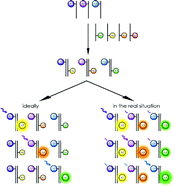FRET can be used as a strategy to assign different simultaneous events in the same sample but “cross-talk” problems are a limitation. Here we present a contribution for the better understanding of the “cross-talk” in FRET experiments that include several pairs in the same sample. Using oligonucleotide probes labeled with fluorescent dyes which can be selectively excited at a specific wavelength, and using target oligonucleotides tagged with a fluorescent dye with specific characteristics that allow only it to emit light upon selective excitation of a specific probe by energy transfer (FRET), we aim to identify the exact probe–target hybridized pair. When using three donors to probe the presence of complementary targets, only 20% of possible donor/acceptor combinations give straightforward signals readily identifiable with the sample composition, while in the remaining cases severe cross-excitation prevents the direct identification of the sample composition. To correctly resolve the samples identity, we developed a theoretical model that enables the unequivocal attribution of a sample composition to a given set of fluorescence signals, in the presence of three donors.

You have access to this article
 Please wait while we load your content...
Something went wrong. Try again?
Please wait while we load your content...
Something went wrong. Try again?


 Please wait while we load your content...
Please wait while we load your content...